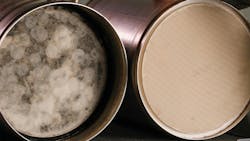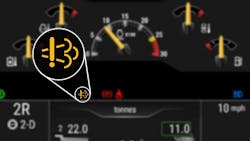How to Maintain Diesel Particulate Filters
Key Highlights
In this article, you will learn:
- How DPFs trap soot and ash to reduce emissions.
- How regular maintenance acn prevent DPF failure and costly replacements.
- Signs of DPF issues that should prompt immediate attention.
- How proper oil and fuel selection can extend DPF service life.
As the beating heart of every machine, the engine and all of its components require proper care to prevent costly downtime. The aftertreatment system plays a critical role in optimizing the performance of the engine, but it often doesn’t get the attention it deserves. In particular, equipment owners should understand the importance of diesel particulate filters (DPFs) and their service lives.
The main function of the DPF is to trap soot and ash from exhaust fumes, which is critical for reducing emissions and ensuring compliance with regulatory standards.
DPFs collect and filter out two different particulates: soot and ash. Soot is generated by the incomplete combustion of diesel fuel, which is typical in normally operating diesel engines.
Through a process called regeneration, soot that has accumulated in the DPF’s ceramic substrate is heated and converted into carbon dioxide gas, which flows through the DPF and exits through the exhaust stack.
Residue left behind after regeneration is ash, which consists of metallic compounds originating from a number of sources: lubricant additives, trace elements in diesel fuel, and by-products of engine wear and corrosion.
Although soot can be oxidized and removed as a gas during regeneration, ash does not combust and becomes trapped in the walls of the DPF substrate. As it accumulates, the ash tends to harden, limiting the collection of soot to only a portion of the filter channels. An obstructed DPF can also restrict exhaust flow and increase backpressure, which degrades engine performance and increases fuel consumption.
The ongoing build-up of particulates triggers more frequent DPF regeneration cycles, resulting in a decrease in overall machine fuel economy and reduced reliability of the aftertreatment system. When the channels of the DPF become plugged with ash, it becomes prone to “hot spots,” which are areas within the DPF where soot has accumulated to a level that has the potential to combust, leading to localized cracking, melting, and fusing of the filter substrate. In this case, the DPF would need to be completely replaced, which is up to triple the cost or more of a standard maintenance visit.
Operators may note some warning signs when the DPF begins to fail. A DPF alert may light up on the instrument panel, and they may detect noises, vibrations and reduced engine performance. Other more subtle signs of failure can include frequent regenerations and increases in fuel consumption.
How to preserve optimal functioning of DPFs
First, it’s imperative that equipment owners follow the specific oil and fuel recommendations from the manufacturer. Low-ash engine oil is recommended for most engines meeting Tier 4-F and Tier 4-I emission standards.
Leading engine manufacturers follow robust formulation and testing processes to make sure their approved lubricants excel in every way, including oxidation control, soot handling, deposit prevention, low-temperature pumpability, cleanliness, and shear stability, among others. The American Petroleum Institute (API) sets standards for engine oil performance, and oils for engines with DPF systems should be clearly labeled as meeting or exceeding API’s CK-4 criteria.
Beyond the engine oil service, DPFs have standard maintenance service intervals specified by the manufacturer as well. This means the DPF should be removed, inspected, cleaned, reinstalled, and tested by a trained service professional.
During this service, technicians note that the DPF will almost always be black with accumulated soot at the inlet, but a properly functioning filter has a clean, smooth surface at the outlet with no indication of soot tracking or any other build up. If otherwise, then the DPF may be damaged and need to be replaced.
When considering the maintenance intervals for your DPF, it’s critical to factor engine idle time into this equation. An idling engine passes more oil past the piston rings than it does at normal operating speeds, which accelerates the deposit of ash downstream in the DPF and can significantly decrease service intervals.
Many factors contribute to idle time, such as poor weather, inefficient workflows, or outdated operator habits. Although excessive idle time affects numerous other aspects of machine performance—increased fuel costs, quicker engine wear, depleted batteries—equipment owners should also account for its impact on DPF performance and maintenance schedules as well.
Every operation is unique, and every machine on a job site has its own duty cycles. Equipment owners can manage DPF performance and maintenance by turning to technicians certified by the OEM.
Component Moment
Caterpillar engine experts Nick Johnson and Jack Maroney provide valuable tips and tricks in Caterpillar’s “Component Moment” video series (below). These brief yet informative tutorials are designed to help equipment owners get ahead of common issues, improve maintenance practices and keep machines running smoothly.
DPF maintenance is far more complex than simply running a shop vac over it, and it’s costly to replace if service is performed incorrectly. This is why full-service OEMs offer a full suite of aftermarket solutions for DPFs and other engine components that include preventive maintenance, expert technical inspections, and support, and genuine replacement parts.
Advanced digital services can also be employed to support optimal DPF performance. They are configured to collect and communicate DPF-specific data in real time on soot load percentage, regeneration status and efficiency, temperature and pressure, emissions error codes, and other metrics. They also track data upstream and downstream that may also indicate an issue with the DPF, such as fuel efficiency, engine load, and exhaust temperature.
This data can then be processed by data mining and predictive analytics algorithms to detect patterns and predict issues with the DPF and other emissions components long before they result in downtime. Insights and recommendations can then be fed to equipment owners through an easy-to-understand dashboard conveniently accessed on a smart device.
Engine aftertreatment is vital for keeping equipment productive and in optimum working order. By understanding how DPFs work and what’s required to properly maintain them, equipment owners can reduce downtime, lower service costs, optimize fuel efficiency, and ultimately get the most out of their machines.
About the Author
Nick Johnson
Nick, Cat engine component specialist, is a second-generation "Cat Guy" who has had his hands inside of engines since he was a little kid. He has been with Caterpillar since 2004 and spent many years supporting dealers with engine rebuild and salvage practices and now enjoys sharing his expertise with customers and dealers. In his off time, he’s either in his home shop, riding ATVs with his son, or traveling in the RV with the family.
Jack Maroney
Jack, Caterpillar market professional, has been with Caterpillar since 1995. Throughout his career, he has played a key role in the launch of numerous new products, including Cat diesel engines and aftertreatment systems. Jack brings a wealth of experience in product development and validation, along with valuable lessons learned, which he shares with dealers and customers around the globe. Outside of work, you will find Jack in his garage turning a wrench on one of his many projects, spending time with his family, and cleaning up after his four Chihuahuas: Coco, Tommy, Pixel, and Delilah.


